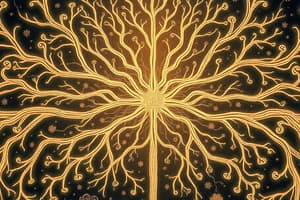Podcast
Questions and Answers
Which part of the nervous system is responsible for involuntary functions such as breathing and heart rate?
Which part of the nervous system is responsible for involuntary functions such as breathing and heart rate?
- Cerebrum
- Brain Stem (correct)
- Spinal Cord
- Cerebellum
The peripheral nervous system includes the brain and spinal cord.
The peripheral nervous system includes the brain and spinal cord.
False (B)
Name the two main components of the Central Nervous System.
Name the two main components of the Central Nervous System.
Brain and Spinal Cord
The _____________ connects the brain to the spinal cord.
The _____________ connects the brain to the spinal cord.
Match the divisions of the Peripheral Nervous System to their functions:
Match the divisions of the Peripheral Nervous System to their functions:
What main part of the brain is responsible for balance and coordination?
What main part of the brain is responsible for balance and coordination?
The spinal cord is the primary processing center for the nervous system.
The spinal cord is the primary processing center for the nervous system.
What system regulates the body's responses to internal and external stimuli?
What system regulates the body's responses to internal and external stimuli?
Flashcards
What is the nervous system?
What is the nervous system?
The nervous system is the body's control center, made up of nerves and cells that communicate messages to and from the brain and spinal cord.
What is the central nervous system (CNS)?
What is the central nervous system (CNS)?
The central nervous system (CNS) acts as the main processing hub for the nervous system, receiving and sending information to the rest of the body.
What is the brain?
What is the brain?
The brain, located within the skull, controls everything from your thoughts to your movements.
What is the cerebrum?
What is the cerebrum?
Signup and view all the flashcards
What is the cerebellum?
What is the cerebellum?
Signup and view all the flashcards
What is the brain stem?
What is the brain stem?
Signup and view all the flashcards
What is the spinal cord?
What is the spinal cord?
Signup and view all the flashcards
What is the peripheral nervous system (PNS)?
What is the peripheral nervous system (PNS)?
Signup and view all the flashcards
Study Notes
The Nervous System
- The nervous system is a complex network of nerves and cells that carry messages to and from the brain and spinal cord to various parts of the body.
- It connects all body parts, transmitting signals between them.
- It's a system of cells, tissues, and organs that regulates the body's responses to internal and external stimuli.
- Every part of the nervous system plays a specific role.
Major Divisions of the Nervous System
- Central Nervous System (CNS): The main processing center of the nervous system.
- Consists of the brain and spinal cord.
- Peripheral Nervous System (PNS): Connects the CNS to organs and limbs.
- Has two main divisions: somatic and autonomic.
Central Nervous System (CNS)
- Brain: Organ located within the skull, acting as the organizer and distributor of information for the body.
- Contains three main parts:
- Cerebrum: The large, upper part of the brain responsible for activity and thought.
- Cerebellum: Located below the cerebrum, controlling posture, balance, coordination.
- Brain stem: Connects the brain to the spinal cord, controlling automatic functions like breathing, digestion, heart rate and blood pressure.
- Contains three main parts:
- Spinal cord: Acts as a channel for signals between the brain and the majority of the body parts. It controls some simple musculoskeletal reflexes.
Peripheral Nervous System (PNS)
- Somatic Nervous System: Associated with voluntary control of body movements.
- Includes:
- Spinal nerves: Carry motor and sensory signals between the spinal cord and the body.
- Cranial nerves: Carry information to and from the brain stem.
- Includes:
- Autonomic Nervous System: Associated with involuntary control of body movements.
- Includes two subdivisions:
- Sympathetic Nervous System: Activated during stress or dynamic situations, increases heart rate, breathing, pupil dilation, and sweating.
- Parasympathetic Nervous System: Maintains body functions and restores the body to a normal or relaxed state.
- Includes two subdivisions:
Studying That Suits You
Use AI to generate personalized quizzes and flashcards to suit your learning preferences.




